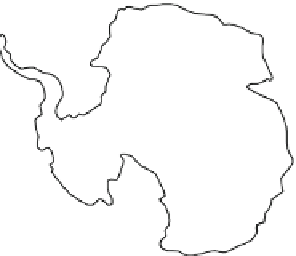Geology Reference
In-Depth Information
the presence of phlogopite, olivine, diopside, leucite and spinel. There are also
lamproite dykes at Pniel, Post Masburg and Pielansburg in Johannesburg.
4.3.5 K-Rich Rocks from Mt. Etinde, West Africa
Mt. Etinde is located on the Cameroon line, northwest of the Congo Craton and
south of the West African Craton (Nkoumbou et al. 1995). It is essentially a
volcano, which had been erupting mainly nephelinitic rocks during the Quarternary
period, but it also erupted mela-nephlinites, leucitites, leucite nephlinites and leu-
cite-melilite-bearing nephlinites. The last mentioned rock type includes phenocrysts
of ha
yne, pyroxene, nepheline, leucite and aenigmatite. The eruption of lava of
Mt. Etinde took place essentially 0.065
+
0.1 and 1.1 Ma ago.
ü
4.4 The Lamproitic Rocks from Antarctica
The lamproitic rocks have been described from Gaussberg, Mount Bayliss and
Priestly Peak from Antarctica by Sheraton and Cundari (1980), Sheraton and
England (1980) and Collerson and McCulloch (1983). According to Stephenson
(1972) and Nougier (1972) the Kerguelen-Gaussberg ridge has been the center of
extensive hot-spot activity during the last 27 Ma.
Gaussberg (68
E) is an extinct volcanic cone located on the coast of
Wilhem II land, Antarctica (Fig.
4.11
). The cone is 370 m high without a crater and
consists of pillow lavas. The pillows are best exposed around the lower part of the
mountain and are 50 cm
°
48
′
S, 89
°
19
′
2 m across (Sheraton and Cundari 1980). The most of the
lavas are vesicular. The pillows have a well-de
-
ned black glassy crust about
3
5 cm thick. Partially fused crustal xenoliths (up to 15 cm across) mostly of
granitic composition are common.
-
Fig. 4.11 Location of
Gaussberg volcanic
field in
Antarctica (after Sheraton and
Cundari 1980)
0
0
Kerguelen
Heard
Gaussberg
90
0
E
ANTARCTICA
Ross Sea























































































Search WWH ::

Custom Search